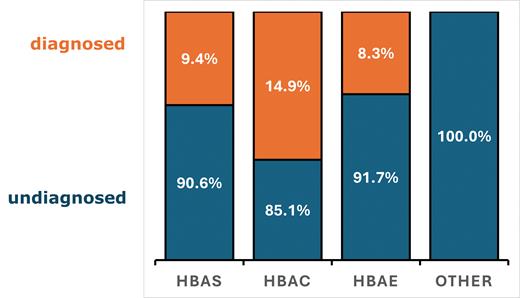Hemoglobinopathies are among the most common inherited red blood cell disorders, yet they remain underrecognized in routine clinical practice — particularly in patients presenting with anemia or microcytosis. In a retrospective review of 35,684 hemoglobin A1c samples using a high-performance liquid chromatography-based method at our institution, hemoglobin variants were incidentally detected in 1.4% of cases (n=491) (Figure).1 Strikingly, 85% to 100% of these patients were unaware of their carrier status. Diagnosis status was determined by reviewing the electronic medical record for documentation of a known hemoglobin variant; absence of such documentation was classified as “undiagnosed.” This lack of awareness spans all age groups, despite universal newborn screening programs.
Percentage of patients with hemoglobin variants who were diagnosed versus undiagnosed, by variant type
Abbreviations: HbAC, hemoglobin C trait; HbAE, hemoglobin E trait; HbAS, hemoglobin S/sickle cell trait.
Percentage of patients with hemoglobin variants who were diagnosed versus undiagnosed, by variant type
Abbreviations: HbAC, hemoglobin C trait; HbAE, hemoglobin E trait; HbAS, hemoglobin S/sickle cell trait.
Among the 491 samples flagged for hemoglobin variants, sickle cell trait was the most common, accounting for 72.5% (n=356) of cases. Hemoglobin C trait and hemoglobin E trait accounted for 19.1% (n=94) and 4.9% (n=24), respectively. The remaining 3.5% (n=17) included other variants, such as homozygous conditions or fetal hemoglobin over 30%. These variants are often clinically silent but can be misinterpreted as iron deficiency anemia, especially in heterozygous carriers.
Importantly, the American College of Obstetricians and Gynecologists now recommends universal screening for hemoglobinopathies during prenatal care2 — a shift from earlier guidelines that focused only on high-risk ethnic groups. This change reflects the growing understanding of hemoglobin variant prevalence and the importance of unbiased screening practices.
We encourage clinicians to consider hemoglobinopathies in the differential diagnosis of anemia and microcytosis across all age groups and ethnic backgrounds. Greater awareness and proactive evaluation can improve diagnostic accuracy, prevent mismanagement, and support informed reproductive decision-making.
Disclosure Statement
Dr. Fan indicated no relevant conflicts of interest.

